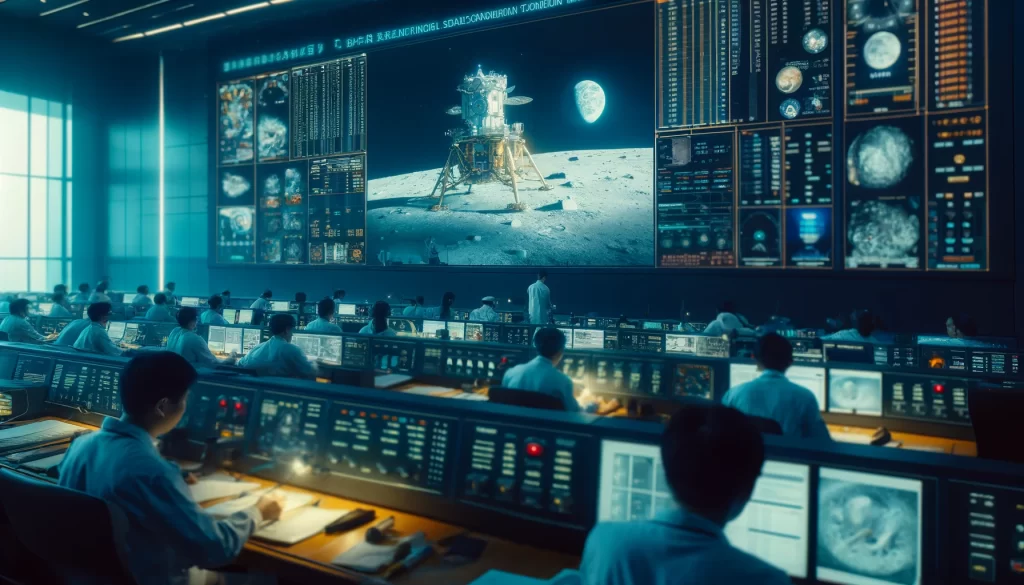On Sunday, China successfully landed its uncrewed Chang’e 6 spacecraft on the far side of the moon, marking a significant milestone in space exploration. This mission, undertaken by the China National Space Administration (CNSA), is aimed at retrieving rock and soil samples from a region that has never been explored before. If successful, this will be the first mission in history to return samples from the far side of the moon.
Mission Details and Challenges
The Chang’e 6 probe landed at 6:23 a.m. Beijing time (2223 GMT) in the South Pole-Aitken basin, one of the oldest and largest impact craters on the moon. The mission was launched on May 3 from the Wenchang Space Launch Center on the southern island of Hainan, using a Long March 5 rocket. The probe’s landing marks China’s second successful mission to the moon’s far side, following the Chang’e 4 mission in 2019.
Landing on the far side of the moon is particularly challenging due to the lack of direct communication with Earth. Radio waves are blocked by the moon’s solid rock, necessitating the use of relay satellites to send signals to the spacecraft. This complexity makes the far side landings difficult. “Landing on the moon is difficult, but doing so on the far side, where communications are particularly difficult, is an enormous technical achievement,” said Professor Martin Barstow of the University of Leicester. Neil Melville-Kenney, a technical officer at the European Space Agency, also noted the difficulty, explaining that automation is challenging, especially at high latitudes with long shadows that can confuse landers.
Scientific and Strategic Significance
The mission aims to collect approximately 2 kilograms of lunar material using a scoop and drill. The samples will be collected over two days and then sent back to Earth. The return journey involves transferring the samples to a rocket booster atop the lander, which will launch back into space, rendezvous with another spacecraft in lunar orbit, and eventually land in China’s Inner Mongolia region around June 25.

The South Pole-Aitken basin, where the probe landed, is of great scientific interest because it is an enormous impact structure that may contain materials from deep within the lunar crust. “The new samples could have preserved details of the chemistry and history for a region of the moon’s sub-surface we haven’t had access to before,” said Professor Neil Bowles from the University of Oxford. These samples are expected to provide unprecedented insights into the moon’s formation and evolution, as well as the history of the solar system. “Scientific analyses of these returned lunar samples using modern analytical methods and techniques could reveal new insights into the formation and evolution of the moon and by extension that of the solar system itself,” added Professor Mahesh Anand of the Open University.
International Space Race
China’s ambitious lunar mission underscores the growing international competition in space exploration. Countries like the United States, Japan, India, and Russia have all invested heavily in space programs. For China and the United States, in particular, a rivalry is escalating over scientific frontiers in space. The United States plans to send humans to the moon again as soon as 2026 through NASA’s Artemis program, while China aims to land its first astronauts on the moon by 2030. The U.S. Artemis program involves partnerships with space agencies from Canada, Europe, and Japan.
The successful landing of Chang’e 6 not only highlights China’s technical capabilities but also elevates its status in the global space race. “This knowledge will be a huge step forward for lunar and planetary science,” said Professor Katherine Joy of the University of Manchester. Dr. Simeon Barber of the Open University remarked on the broader implications, stating, “The return of these first samples from the far side provides entirely new pieces in the jigsaw to help us decipher the shared history of the moon and Earth, and the conditions through which our planet evolved and came to sustain life”.
Future Prospects
China’s lunar strategy includes developing key sampling technology, as well as takeoff and ascent capabilities from the far side of the moon. The mission is part of China’s broader plan to establish a presence on the moon, which includes sending astronauts and building an inhabited lunar base in the future. The CNSA’s success with Chang’e 6 is a critical step towards these long-term goals, demonstrating their ability to overcome significant technical challenges and contribute valuable scientific knowledge.
This article is based on the following articles:
https://www.reuters.com/technology/space/china-lands-uncrewed-spacecraft-far-side-moon-2024-06-01
https://www.washingtonpost.com/world/2024/06/02/china-space-change-6-moon-dark-side

Background Information
The Moon and Its Exploration
The Moon’s Geography:
- Near Side vs. Far Side: The moon has two hemispheres: the near side, which faces Earth and is familiar to us, and the far side, often referred to as the “dark side” because it is never visible from Earth. However, “dark” doesn’t mean it lacks sunlight; it simply means it is permanently hidden from our view due to the moon’s synchronous rotation with Earth.
- South Pole-Aitken Basin: This is one of the oldest and largest impact craters in the solar system, located on the far side of the moon. It spans about 2,500 kilometers in diameter and is of great scientific interest because it may contain materials from deep within the lunar crust.
History of Lunar Exploration:
- Apollo Missions: The United States conducted the first successful manned moon landing with Apollo 11 in 1969. The Apollo missions provided valuable data about the moon’s surface and brought back lunar samples.
- Soviet Luna Program: The Soviet Union’s Luna program achieved the first uncrewed landing and sample return missions in the 1960s and 70s.
- Modern Missions: In recent years, various countries, including the United States, China, India, and Japan, have launched missions to explore the moon’s surface.
Challenges of Far Side Exploration
Communication Difficulties:
- Direct communication with the far side of the moon is impossible because radio waves cannot penetrate the moon’s solid rock. To overcome this, missions must use relay satellites positioned to transmit signals between Earth and the spacecraft.
Technical Challenges:
- Landing Difficulties: The far side’s rough terrain, characterized by deep craters and long shadows, makes landing operations more complex and risky.
- Automation: Due to communication delays and the need for real-time decision-making, spacecraft on the far side must operate with a high degree of autonomy.
China’s Lunar Program
Chang’e Missions:
- Chang’e 1-4: Named after the Chinese moon goddess, these missions include orbiters, landers, and rovers that have progressively explored the moon, culminating in the Chang’e 4 mission, which made the first soft landing on the far side of the moon in 2019.
- Chang’e 5: In 2020, Chang’e 5 successfully returned samples from the near side of the moon, demonstrating China’s growing capabilities in space exploration.
Chang’e 6 Mission:
- Objectives: The primary goal of Chang’e 6 is to retrieve rock and soil samples from the South Pole-Aitken basin, providing unprecedented data about the moon’s far side and contributing to our understanding of lunar and solar system history.
- Technological Innovations: The mission incorporates advanced automation and engineering solutions to handle the complexities of far side operations.
The Global Space Race
Historical Context:
- The space race began during the Cold War, primarily between the United States and the Soviet Union. The competition drove significant advancements in space technology and exploration.
- Today, the space race includes many countries and private companies, all aiming to achieve scientific breakthroughs, national prestige, and potential economic benefits from space resources.
Current Rivalries:
- U.S. Artemis Program: The United States plans to return humans to the moon by 2026 and establish a sustainable presence through the Artemis program, which involves international partnerships.
- China’s Ambitions: China aims to land astronauts on the moon by 2030 and is working towards creating an inhabited lunar base.
Scientific Importance of Lunar Samples
Understanding Lunar History:
- Samples from the moon provide critical information about its composition, geological history, and the processes that have shaped its surface.
- Comparing samples from different regions (near side vs. far side) helps scientists understand the moon’s asymmetry and the differences in geological activity.
Insights into the Solar System:
- Lunar samples can offer clues about the early solar system, including the formation and evolution of planetary bodies.
- Studying the moon’s impact craters, such as the South Pole-Aitken basin, can reveal details about the history of cosmic collisions and their effects on planetary surfaces.
Technological Advancements:
- Missions like Chang’e 6 push the boundaries of space technology, leading to innovations that can be applied to other areas of science and industry.
Future Prospects
Sustainable Lunar Presence:
- The goal of many space programs is to establish a sustainable human presence on the moon, which involves creating habitats, mining resources, and developing infrastructure.
- These efforts pave the way for future exploration of Mars and other distant celestial bodies.
International Cooperation and Competition:
- While competition drives rapid advancements, international cooperation is also crucial for sharing knowledge, resources, and ensuring the peaceful use of space.
Please subscribe to Insight Fortnight, our biweekly newsletter!
